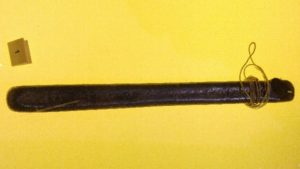It may not look like much, but to me this is the most perfect exhibit in London’s Science Museum:
This modest bar, about 25cm long, is displayed recessed in a bench seat. Thousands of people sit on it every year, without much thought to its significance, I suspect. That’s actually quite understandable, because it is surrounded in the Making the Modern World gallery by other staggering achievements. The Volkswagen Beetle, a huge glass lighthouse ‘eye’, Stevenson’s Rocket (yes, the real one) and an imposing 1,000,000-Volt electron accelerator. But if you cast your eyes downward, you find this rod. It’s from the world’s very first batch of aluminium.
Aluminium, as we’re taught in Chemistry lessons, is manufactured in two phases: after mining the bauxite ore to obtain aluminium oxide, you refine it, and then smelt the aluminium oxide to release aluminium. It’s an industrial operation which requires 4 times the weight in bauxite ore as you get out in aluminium. And it is highly energy-intensive; the smelting alone requires huge amounts of electricity.
The Science Museum sample was manufactured differently, in 1855, by the prolific French scientist Henri Sainte-Claire Deville. At the time he started studying its commercial production, Deville knew of two possible ways of converting aluminium chloride to aluminium. The first was an electrolytic method using a carbon anode and a platinum cathode (problem: cheap electricity was difficult to come by in the 1850s). The second was chemical, using potassium as an agent to reduce the aluminium chloride.
Recognising the danger of working with potassium, Deville opted for something new: using sodium as the agent. His process was a success. One measure is that his new metal was exhibited at the 1855 Exposition Universelle, in Paris, with the catchy slogan “silver from clay”.
Partly thanks to the work of Deville, by 1890 the cost of aluminium was around 1% of that 35 years earlier.
(Side note. Monsieur Deville was also instrumental in the separation of many other metals, including silicon, chromium, magnesium, iridium, platinum, osmium, and manganese. And the other impressive way in which he has impacted the world was through his development of an alloy of iridium and platinum, which formed the basis for the first International Prototype kilogram and metre.)
The fact that the Science Museum has the first batch of aluminium is astounding. The story of its creation gives a window on the creativity of scientists and engineers who discover complex processes which enrich all our lives.
Oh, and this particular rod has also passed through the hands of scientific royalty. After being created, it was given to Michael Faraday, who used it in his experiments and lectures.
Look down.
